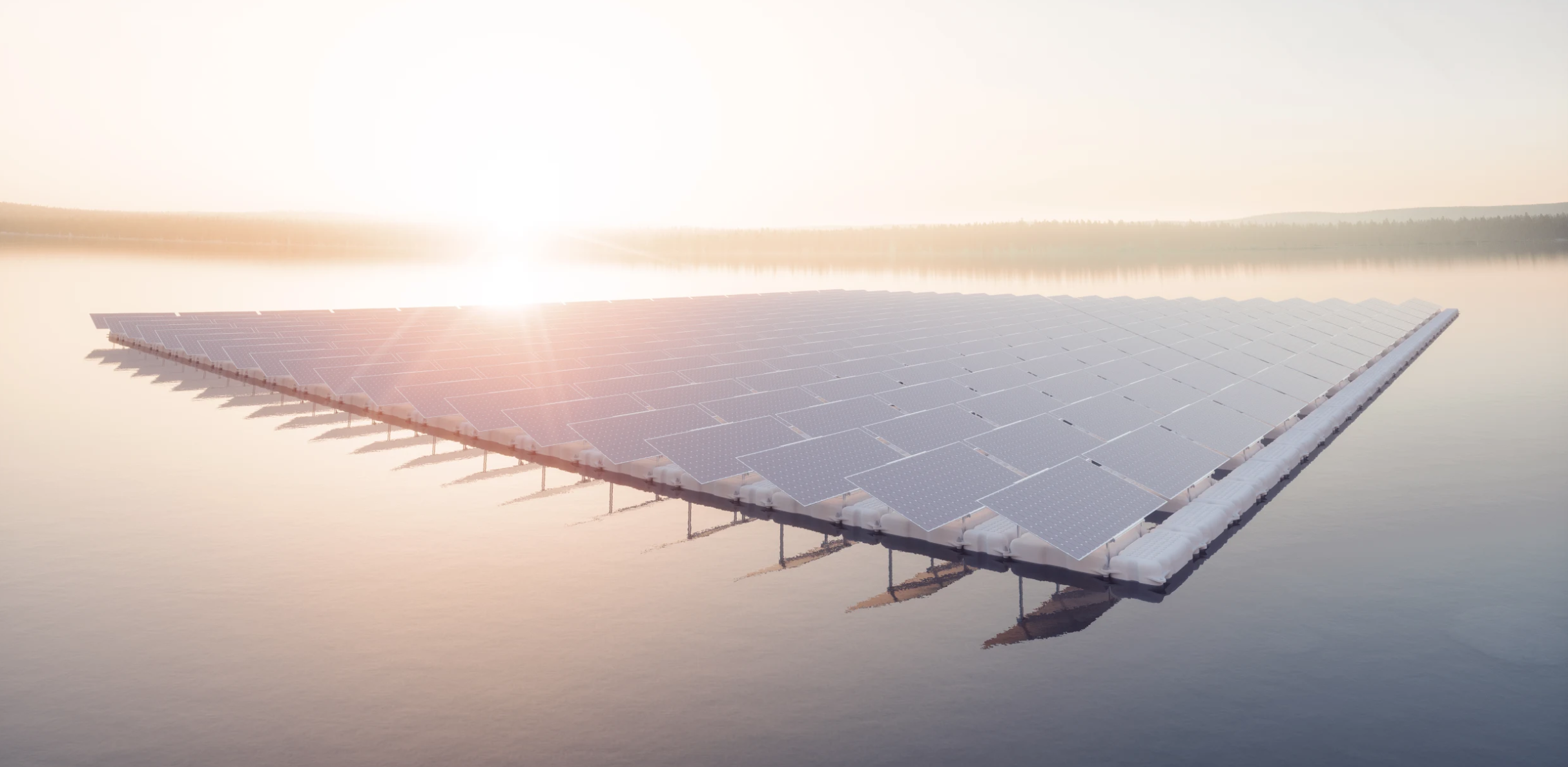
Source: Shutterstock
Written by James Wayne
Edited by James Warren and Kara Guse
In the summer of 2020, New York passed the Climate Leadership and Community Protection Act (CLCPA) and declared the goal of achieving 70% renewable energy by 2030, setting up New York to be a leader in the transition to a decarbonized electricity sector.[1] However, the state was quickly confronted with the question of how to reach this target. Solar power is mature, cheap, and easy to implement but it also requires large areas of open land. Competing demands for land from small family farms, reforestation initiatives, and solar power mean that land use will become an increasingly fraught issue. New York is one of the US’s most forested states, at 63% forest by land, which is nearly double the percentage of forests as California; this, combined with increasing demand for locally grown food and thriving New York farms, mean that land is precious and scarce.[2],[3] These developments are positive from a climate mitigation standpoint, but due to extensive infrastructure, renewable energy, farms, and forests can not be in the same place at the same time.
New York State guidance on land leases for solar development suggests that a megawatt (MW) of solar power uses between 6 and 10 acres of land.[4] The CLCPA aims to develop 6,000 MW of solar energy by 2025, tripling its 2019 renewable energy generation and scaling that up considerably to reach 2030 targets. In context, 6,000 MW is enough to power 960,000 homes in New York.[5] Using those numbers, New York State needs to find between 36,000 and 60,000 new acres of land for solar development. Ideally, this land is flat, contiguous, and located near substations or transmission lines. Currently, the land that meets these criteria is most often farmland. Landowners and municipal governments are increasingly faced with the question of whether to continue to use the land to produce food, often sold locally, or lease the land to solar developers for a fixed income. Large scale solar arrays are often met with resistance by rural New Yorkers who see their way of life vanishing.[6] More and more, local municipalities are banning utility scale solar power and seeking to block the development of large scale solar projects.[7]
Even as farmers and municipalities resist developing solar projects, the demand for solar energy has increased with the goals set forth by the state. Developers will need to look to New York’s forests for space for their projects. However, this is counterproductive to the emissions targets put forth by the CLCPA. New York forests act as an immense carbon sink and any destruction would increase GHG emissions. Over 75% of New York State forests are held in private hands.[8] These landowners are under no obligation to keep their forests and may well be swayed by solar developers to create open land for utility scale solar generation. New York State forests directly contribute 14 billion dollars to the economy and their ecosystem and environmental services indirectly provide significantly more value .[9],[10]
While New York is reaching toward the most ambitious renewable energy portfolio goals in the country, the federal government is also poised to increase its spending in this area. President-elect Joe Biden is under considerable pressure to pass a large stimulus package to revitalize the US economy and has unveiled a two trillion dollar clean energy and infrastructure plan to help build out renewable energy all across the country.[11] Forward-thinking state governments will be ready with ideas and projects so that once the bill is passed, they can be the first to capture that money and begin development. One idea that can help reduce the demand on land use and bring the state closer to achieving its renewable energy goals is utilizing the vast open spaces of New York’s lakes.
Floating Solar Photovoltaics
Floating solar panels (FPVs) were first developed in Japan in 2007 and have since been adopted by dozens of other countries. Much of this deployment has been centered in East Asian markets, with countries like China and Japan taking the lead. These countries have additional incentives for these projects due to dense populations and limited land availability. States in the US have also started to adopt the technology; in 2019, New Jersey completed the largest floating solar array in North America: a 4.4 MW project on a reservoir in Sayreville.[12] Small scale projects in California and Florida are also in the works. According to the World Bank, there were 1,300 MW of floating solar power deployed globally in 2018, and each year, that number grows exponentially.[13]
The technology for FPVs has already been invented, and beyond cost, there are no significant resources, technology, or expertise deficiencies for these projects. Most projects built so far include traditional solar panels on a platform of floats or pontoons which are anchored and moored to the lake floor or the shore. The system must be built to withstand high winds and waves so that it does not move out of alignment with the sun. Land-based solar panels often need extensive infrastructure to connect the power to the electricity grid. Because FPVs are often built on the lakes around hydroelectric facilities, much of the infrastructure for interconnection with the grid is already in place.[14]
FPV arrays are considered to be environmentally benign, and in some cases, beneficial to the water. FPVs have two major benefits to the areas where they are deployed. The first is evaporation reduction; New York reservoirs lose millions of gallons of water per year to evaporation, and while New York is generally abundant in freshwater, droughts are likely to become more frequent due to climate change.[15] Floating solar panels cut down on evaporation by reducing solar irradiation and wind effects on the water.[16] The reduction in evaporation allows the hydroelectric plant to work at maximum capacity more often. A research paper in the Journal for Energy Conservation and Management estimated that FPVs could improve the energy capacity of hydroelectric facilities by 76%.[17] FPVs limit evaporation by preventing sunlight from hitting the water and reducing harmful algae growth, which contaminates drinking water and further reduces the efficiency of hydroelectric facilities.[18] Lastly, the cooler temperatures of water in the summer and the warmer water temperatures in the winter improve the efficiency of the solar panels themselves, making them more efficient than land-based solar panels.[19]
The biggest hurdle for these projects is cost; The World Bank estimates that an optimistic price per kilowatt hour(KWh) is between seven to nine cents compared to between four and six cents for ground mounted solar.[20] The majority of the price difference comes from the floatation, mooring, and anchoring of the array in reservoirs. As with any new technology, this price is expected to decrease as the scale of development increases. However, by putting solar panels on lakes and reservoirs, developers avoid costly land management projects as the area doesn’t need to be cleared of trees or leveled. These are engineering issues rather than technological which means these problems can be solved using already available tools.[21] With the electricity infrastructure already in place, the first projects should be implemented on lakes created by hydroelectric dams.
New York Hydroelectric Dams
With seven large scale hydroelectric facilities that generate over 5,000 MW of electricity annually, New York State has a robust hydroelectric power system.[22] In fact, according to the New York Power Authority, New York generates more electricity from hydro than any state east of the Rocky Mountains.[23] Behind these power plants lie massive reservoirs and huge areas of open, flat, and underutilized space. The Ashokan Reservoir, which is located in the Catskills, provides a maximum output of 4.6 MW and clean drinking water to New York City, is over 8,000 acres.[24] The Hinckley Reservoir in Oneida county and the Niagara Power Reservoir are both over 2,500 acres.[25][26] Other massive reservoirs are scattered throughout the state and provide electricity and drinking water to the communities surrounding them and New York City. A full GIS analysis will likely reveal tens of thousands of additional acres for development. These areas provide massive open spaces that are occasionally used for recreation but have underutilized economic potential. Using the six acres per MW ratio, a solar array on one-fourth of the Ashokan Reservoir could provide an additional 330 MW of renewable energy to the state of New York.
Conclusion and Recommendation
New York State should consider itself a leader in climate change mitigation and clean energy generation. It has outlined thoughtful and ambitious targets that will benefit New Yorkers and global communities. To reach these goals, New York must pioneer new solutions to complex problems. One of these solutions could be FPVs. New York could solve several problems at once by tapping into the thousands of acres of flat, open space in close proximity to substations and transmission lines. For these reasons, the New York State legislature should commission a study into the potential of FPV arrays and outline several pilot projects which could begin development when federal funding is made available.
References
Ashokan Reservoir – NYS Dept. of Environmental Conservation. (2015). Ny.Gov. https://www.dec.ny.gov/outdoor/101552.html
Casey, T. (2020, September 14). Something’s Up With Floating Solar Panels And Hydropower. CleanTechnica. https://cleantechnica.com/2020/09/14/somethings-up-with-solar-panels-hydropower-energy-storage-too/
DeMola, P. (2019, December 30). Town of Duanesburg delays vote on PILOT solar deal as questions percolate. The Daily Gazette; The Daily Gazette. https://dailygazette.com/2019/12/30/town-of-duanesburg-delays-vote-on-pilot-solar-deal-as-questions-percolate/
Forests – NYS Dept. of Environmental Conservation. (2020). Ny.Gov. https://www.dec.ny.gov/lands/309.html
Gallucci, M. (2019, December 2). No land, no problem. Floating solar panels might be the next big thing. Grist; Grist. https://grist.org/article/no-land-no-problem-floating-solar-panels-might-be-the-next-big-thing/
Hinckley Reservoir – New York State Canals. (2013). Ny.Gov. http://www.canals.ny.gov/waterlevels/hinckley/index.html
Horton, R. M., Bader, D. A., & Rosenzweig, C. (2014). Responding Climate Change in New York State (ClimAID) – NYSERDA. NYSERDA. https://www.nyserda.ny.gov/About/Publications/Research%20and%20Development%20Technical%20Reports/Environmental%20Research%20and%20Development%20Technical%20Reports/Response%20to%20Climate%20Change%20in%20New%20York
Ianconangelo, D. (2019, July 11). ENERGY TRANSITIONS: Climate, NIMBY concerns drive move to floating power plants. Eenews.Net; E&E News. https://www.eenews.net/stories/1060723367
Niagara Power Project. (2020). Nypa.Gov. https://www.nypa.gov/power/generation/niagara-power-project
Nir, S. M. (2020, March 18). He Set Up a Big Solar Farm. His Neighbors Hated It. The New York Times. https://www.nytimes.com/2020/03/18/nyregion/solar-energy-farms-ny.html
NY Center for Forestry Research and Development, SUNY ESF. (2020). Changes in New York’s Forest Land Area – NYS Dept. of Environmental Conservation. Ny.Gov. https://www.dec.ny.gov/lands/42065.html
NY Power Authority. (2020). Generation Overview. Nypa.Gov. https://www.nypa.gov/power/generation/generation-overview
NYSERDA. (2020). New York Solar Guidebook- Landowner Considerations for Solar Land Leases. NYSERDA. https://www.nyserda.ny.gov/-/media/NYSun/files/Land-lease-Considerations.pdf
Quaranta, E. (2020, May 28). Floating solar + hydropower hybrid projects can benefit both technologies. Solar Power World. https://www.solarpowerworldonline.com/2020/05/floating-solar-hydropower-hybrid-projects-can-benefit-both-technologies/
Roberts, D. (2019, June 20). New York passes the country’s most ambitious climate target. Vox; Vox. https://www.vox.com/energy-and-environment/2019/6/20/18691058/new-york-green-new-deal-climate-change-cuomo
Robey, C. (2020, May 8). Small Farms in N.Y. Are Experiencing a Surprising Boom. Here’s Why. The New York Times. https://www.nytimes.com/2020/05/08/nyregion/small-farms-ny-coronavirus.html
Silvério, N. M., Barros, R. M., Tiago Filho, G. L., Redón-Santafé, M., Santos, I. F. S. dos, & Valério, V. E. de M. (2018). Use of floating PV plants for coordinated operation with hydropower plants: Case study of the hydroelectric plants of the São Francisco River basin. Energy Conversion and Management, 171, 339–349. https://doi.org/10.1016/j.enconman.2018.05.095
Smallidge, P. J. (1996). In the series: Getting Started with Forestry. In Cornell University Forestry. https://cpb-us-e1.wpmucdn.com/blogs.cornell.edu/dist/d/5957/files/2015/03/New-Yorks-forests-now-and-then-w408vk.pdf
Strategic Outlook – NYSERDA. (2020). NYSERDA. https://www.nyserda.ny.gov/About/Publications/Program-Planning-Status-and-Evaluation-Reports/Strategic-Outlook
US Department Of Energy. (2020). U.S. Hydropower Potential from Existing Non-powered Dams. Energy.Gov. https://www.energy.gov/maps/us-hydropower-potential-existing-non-powered-dams
World Bank Group, E. (2019). Where Sun Meets Water FLOATING SOLAR MARKET REPORT Public Disclosure Authorized Public Disclosure Authorized Public Disclosure Authorized Public Disclosure Authorized. In Worldbank.org. https://openknowledge.worldbank.org/bitstream/handle/10986/31880/Floating-Solar-Market-Report.pdf?sequence=1&isAllowed=y
- Strategic Outlook – NYSERDA, 2020 ↑
- NY Center for Forestry Research and Development, SUNY ESF, 2020 ↑
- Robey, 2020 ↑
- NYSERDA, 2020 ↑
- Solar Energy Industries Association, 2019 ↑
- Nir, 2020 ↑
- DeMola, 2019 ↑
- Forests – NYS Dept. of Environmental Conservation, 2020 ↑
- Ibid ↑
- Smallidge, 1996 ↑
- Biden, 2020 ↑
- Gallucci, 2019 ↑
- World Bank Group, 2019 ↑
- World Bank Group, 2019 ↑
- Horton et al., 2014 ↑
- World Bank Group, 2019 ↑
- Silvério et al., 2018 ↑
- Quaranta, 2020 ↑
- Ibid ↑
- World Bank Group, 2019 ↑
- Ibid. ↑
- US Energy Information Administration, 2020 ↑
- NY Power Authority, 2020 ↑
- Ashokan Reservoir – NYS Dept. of Environmental Conservation, 2015 ↑
- Hinckley Reservoir – New York State Canals, 2013 ↑
- Niagara Power Project, 2020 ↑





